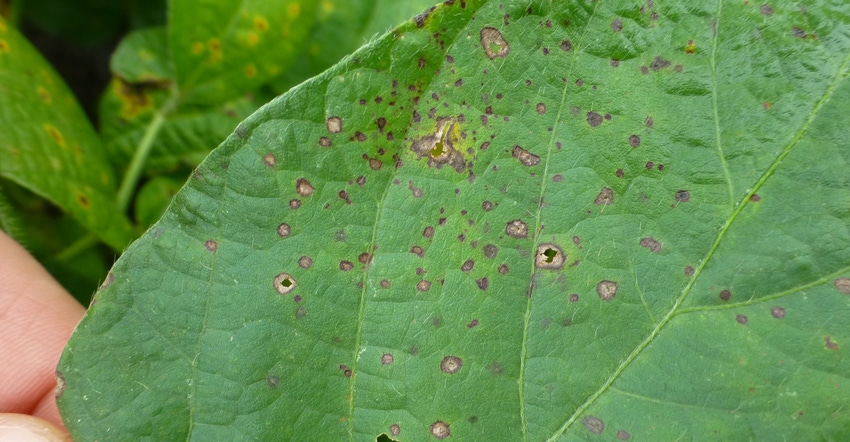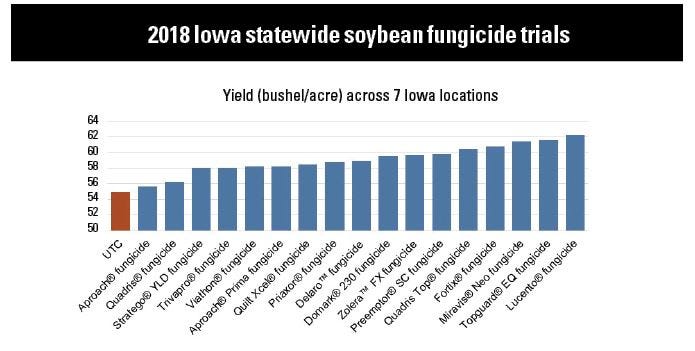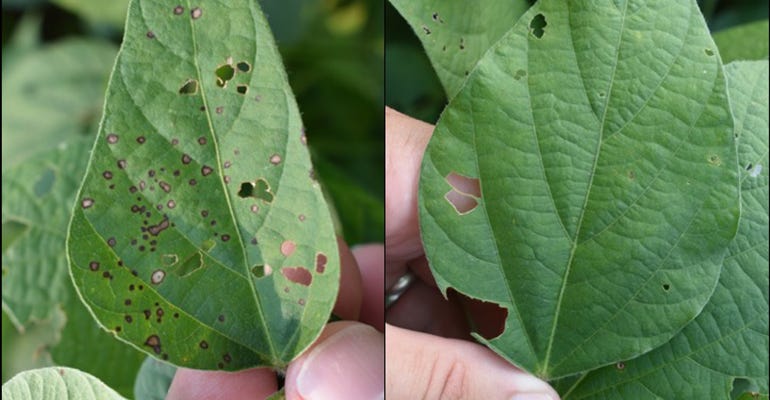June 27, 2019

Soybean growers need to be extra vigilant this summer and keep their eyes open for yield-limiting diseases. With delayed planting and excessive spring rainfall, conditions are aligning for frogeye leaf spot and other foliar diseases.
On top of this, growers in more states are seeing frogeye leaf spot overcome strobilurin (QoI) fungicides from FRAC Group 11, say university crop disease specialists. Strobilurin-resistant frogeye leaf spot has been marching northward and has been confirmed in 14 states, most recently in Iowa and South Dakota.
Frogeye leaf spot was a top soybean disease in Iowa last year, coming in early and strong. “We had quite a bit of frogeye leaf spot showing up in early July when it can affect yields,” notes Daren Mueller, Iowa State University Extension plant pathologist. The fungi could be an economic pest again this year. “Delayed crops can be more prone to yield losses because spores landing on a less-mature crop have more time to damage the plants before harvest.”
Brent Neuberger, technical service manager with FMC in Iowa, urges growers to scout their soybeans. “If we continue to get above-normal precipitation, it likely means more foliar disease. Some diseases like it cool and wet, while others like it warm and wet. But most diseases like wet conditions,” he says.

Heavy rain in September and October 2018 challenged timely soybean harvest in many locations. In ISU trials, the average yield in untreated plots was 54.9 bushels per acre. Yield response to fungicide was statistically significant; the yield response ranged from 0.8 to 7.4 bushels per acre.
While each year is unique, Mueller expects the incidence of frogeye leaf spot will grow in coming years due to farmers planting susceptible varieties and relying too heavily on solo QoI fungicides that are no longer effective.
“Unfortunately, the QoI component of many premixes is becoming worthless. I can only think of a few products in Iowa that don’t have a Qol fungicide in them. We want growers to use fungicides with multiple effective modes of action,” he says.
In 2018’s Iowa State University soybean foliar fungicide trials, the solo Qol fungicides did not perform any better than the untreated check for frogeye leaf spot and septoria brown spot. The top-performing fungicide entry across seven sites in Iowa was Lucento fungicide, a triazole and SDHI premix, which yielded 7.4 bushels more than the untreated check, averaged across seven sites.
Tactics to combat resistance
Plant pathologists recommend farmers use a combination of practices to help control this disease in soybeans:
Plant varieties resistant to frogeye leaf spot.
Use crop rotation.
Apply fungicides only when needed.
Use your phone to pre-scout, monitor spore movement, check weather and see when diseases show up in neighboring states.
Scout soybean fields in July and August at the R1 to R3 growth stage.
Treat at disease onset.
Select fungicides with two modes of action, using non-QoI products.
Apply fungicide at R1 to R3 growth stages.
For more information on soybean foliar diseases, visit the Crop Protection Network at cropprotectionnetwork.org.
Don’t forget about bugs
When scouting soybeans for disease, Neuberger recommends also scouting for insects. “If threshold levels are met, growers can enhance returns by adding an insecticide with their fungicide application,” he says.

COMPARISON: The leaf on the left was from untreated check, and the leaf on the right was from soybeans treated with Lucento fungicide. More growers are seeing frogeye leaf spot disease develop resistance to strobilurin fungicides they apply.

Frogeye leaf spot occurs across the U.S., and significant yield loss can occur when this disease is widespread in a soybean field. Plant pathologists estimate this disease was responsible for more than 17.5 million bushels of lost yield, valued at $158.1 million, across the U.S. in 2015.
In 2010, University of Illinois laboratory assays of resistant frogeye leaf spot isolates showed a 3,000-fold decrease in the pathogen’s sensitivity to a strobilurin fungicide. Even growers who don’t have known resistance should manage their crop as if they do have fungicide resistance, according to Carl Bradley, University of Kentucky plant pathologist.
About the Author(s)
You May Also Like






